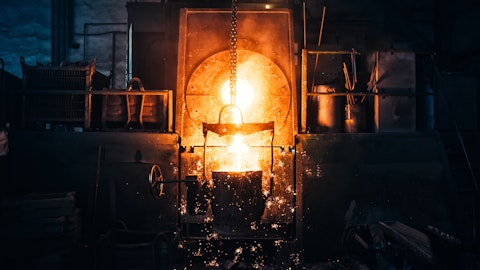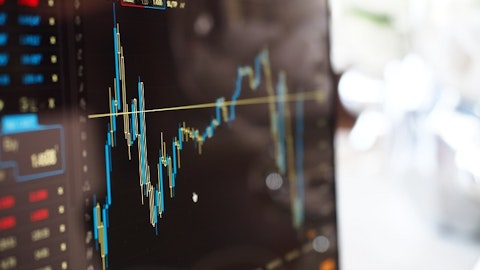Take into account not only 360 days, but the last 90 days. So this is a little bit more sensitive to fluctuations in our level of revenue. So we had a negative impact and increased our cash conversion cycle in days despite a reduction in working capital around R$500 million. For the coming quarters, if we take into account what we’ve seen already in terms of reduction in accounts payable and inventory levels, we expect to continue reducing working capital, trying to go back to normal. Take into account or assuming we won’t have any material changes in sales. Why am I talking about accounts payable and inventories? Because there is an important difference in our inventory terms close to 70 days or 80 days and our account payable, which is close to 30 days.
So what we are decreasing today as accounts payable, there is some mismatch, 30 days or 40 days compared to what will be converted into lower COGS down the road via lower inventory levels. So when we deliver a recurring reduction of inventory levels and accounts payable, working capital is expected to continue.
Gustavo Werneck: Let me add to what Japur said, about CapEx. I would like to highlight something that I recently underscored during the Stakeholders’ Day, but it’s okay to be redundant. It’s important to mention the importance of our investments in mining, in our Ouro Branco mill. Ouro Branco, for the next 40 years, will turn into an absolutely competitive platform to meet the Brazilian domestic market. The former Açominas, which is Ouro Branco mill today, was designed at the time to be a platform to produce semi-finished goods. Blocks, slabs, billets, and over the years we’ve been converting Ouro Branco mill into a very efficient platform to meet the local market with highly added value products. Investments in mining, therefore, will bring us high quality iron ore, concentrated 70% iron.
The mine is just 12 kilometers or 13 kilometers only. And we have evidence that we have resources and funds for the next 40 years. Our forecast for next year, 2024, is to start up a second phase of our investments in coiled hot-roll strips. We have a broad network of Comercial Gerdau with plenty of possibilities to meet our customers’ needs with this additional capacity and investments for future years, expanding our production of structural profiles and other plans for Ouro Branco so it becomes absolutely competitive. So rest assured, how assertive we are in our investments. Sustainable mining, no dams, very low environmental impact. So more specifically about this investment in mining and Ouro Branco, that’s why I want to highlight it again, understand the possibility in the coming years to benefit of results, big results and profitability of our BO in Brazil stemming from this platform which, like I said, is going to be one of the most effective and competitive steel plants for finished goods in Brazil.
Gabriel Simoes: Thank you. Maybe just a brief follow-up about CapEx. When I mentioned about a slightly lower execution in the mats, the idea was to talk about next. So when we think about R$5 billion, like Japur said, you’re very much on track. The investment in next was slightly lower than expected at first, close to R$100 million over the year when your guidance was R$500 million to R$800 million. So the idea is to understand in this front if we expect to see a slowdown of CapEx, known as CapEx, but this investment in next for the coming quarter and if you maintain the idea at the same level for next year.
Gustavo Werneck: Just to give you some concepts, Gabriel, we have no urgency to invest in new business at Gerdau Next. Gerdau Next is a platform of new business. Some of them, we believe they are not promising, so we quickly remove them from our portfolio and businesses that are becoming more mature or as robust to the future. So our investments in Gerdau Next will be very down to earth. From the moment we feel more confident that these businesses are growing and bringing adequate results, we’ll keep on doing, but we have no urgency to allocate capital in Gerdau Next. We’ll be promoting growth of these businesses as we become more confident over the coming years. So I just wanted to — well, rest assured at Gerdau Next we have no need, no urgency to invest as we’ve been doing in other Gerdau Next business, more specifically in Minas Gerais with mining in Ouro Branco, Japur.
Rafael Japur: Sure, it’s so confusing when we think about earnings release and quarterly statements. I was trying to recap exactly the date of our advisory to the market. On October 10, we released an advisory, a notice to the market about the acquisition part of Newave Energia we hold 33.33% of Arinos Solar farm, and we totaled part of the requirements of our investment agreement with Newave Capital in order to complete the portion of around R$500 million, which will happen over Q4. Like we said in the beginning of the year, between allocations at Gerdau Next, we would consider over 2023 between R$500 million and R$800 million, depending on the conditions of the business. If we think about inflow for heavy vehicles at Shandong, where we have the commitment to invest R$125 million and now we are concluding this full share of capital, which is already subscribed at Newave Energia amounting to R$500 million.
Gabriel Simoes: Perfect. Thank you. Crystal clear.
Renata Oliva Battiferro: Thank you, Gabriel.
Renata Oliva Battiferro: Thank you, Gabriel. Our next question from [indiscernible] sell-side analyst from [indiscernible]. He has got two questions for us. The first question, the company should invest R$8.9 million between 2021 and 2026 in initiatives that if I’m not mistaken, should generate an incremental EBITDA of R$4 billion in 2031. I would like to understand what initiatives should pay more contributions to EBITDA and whether the EBITDA increase is linear or not. My second question refers to exploiting the drop of sales in the domestic market in the third quarter of 2023 versus the general industry using ABR data. This discrepancy is due to the mix or the commercial strategy of the company. Could we expect a better performance, I mean, better than the industry in the fourth quarter of this year?
Gustavo Werneck: Ricardo, thank you for your questions. Let me turn the floor to Japur.
Rafael Japur: In terms of CapEx, in the presentation during our Stakeholder Day, it became very clear on the left hand side of this slide, we have the CapEx disbursements that total the strategic CapEx for this window of 2021 to 2026. And that involves several initiatives. The main initiatives that will generate resources refer to investments in our Brazil BD and our sustainable mining operation as we detailed during the presentation. But in that presentation, I’m sure you will find more details and also in our reference form you also have the breakdown per initiative and how much we understand will be our EBITDA contribution throughout the year. Along the same lines, when we talk about a potential EBITDA that could be generated, this is not something that will happen instantaneously.
There is a disclaimer until 2031 as a potential value generation, because even with these investments, there is a ramp up curve. And that’s when we add the volumes of these productive capacity until we can really, you know, release all the potential of all of these initiatives. And then you answer the part about Brazil.
Rafael Japur: Okay, about Brazil Ricardo, this has to do with the mix it’s just normal that throughout the quarter, there are some variations between the numbers that you look at the ABR numbers and then the numbers that you look when you take a look at our quarterly results. So it is usually a mix. Also, the apparent steel consumption remains very sound from January to September of 2023 approximately 1% vis-à-vis 2022. But the demand in the domestic market is quite sound when compared to the previous years. The main issue today, as I said before, already referring to this drop in sales to the domestic market is related to this absurd increase in the penetration of imported steel. When we look at our main market and now, looking at the closing of 2023, and going towards 2024, we remain optimistic that the demand or steel consumption in Brazil will continue to stay at the current levels.
We recently heard something just as an example, that Ministry of the Cities expressed a desire to expand the Minha Casa Minha Vida program to the — to the middle class. So there are many new orders, especially coming from our cut and bend units. And there is an expectation that with a reduction in interest rates, the retail market could also resume demand. And the Industrial segment, even though it went through a more difficult half year with the penetration of imported machinery, it’s a sector of the economy of the economy that is beginning to react. Therefore, the apparent demand remains sound. Therefore, I reiterate the importance of the federal government that in the shortest possible time should introduce efficient measures to fight the penetration coming from this unfair import.



